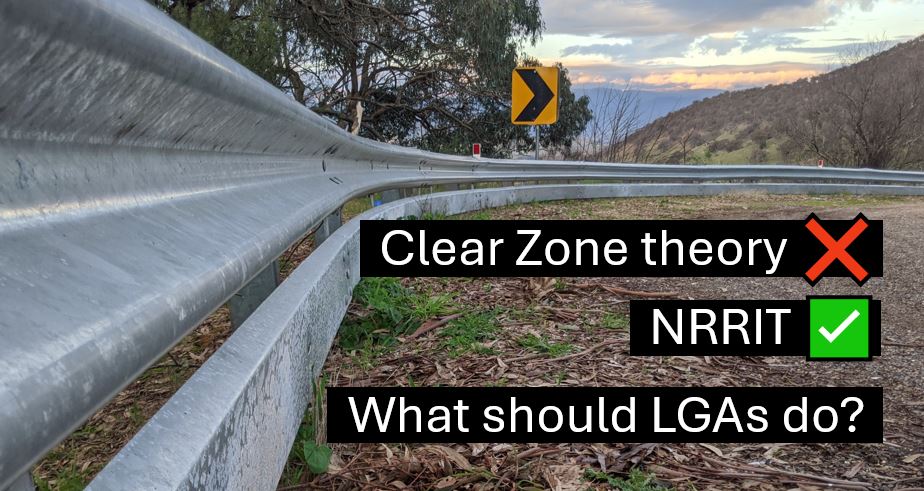
What is NRRIT?
The Network Roadside Risk Intervention Threshold (NRRIT) has replaced the ‘Clear Zone’ approach to managing and assessing roadside risk in Victoria, Queensland and South Australia. It is a key concept in road safety management, used to determine when interventions should be made to enhance roadside safety. It establishes a threshold for acceptable roadside risk levels across a jurisdictional road network which are associated with hazards such as trees, utility poles, or steep embankments. When the risk surpasses this threshold, appropriate actions are required to mitigate the risk.
Interventions may include installing safety barriers, relocating hazards, flattening embankments, or improving road geometry. The primary goal is to reduce the severity of crashes if vehicles leave the roadway, making roadsides safer and lowering the likelihood of severe injuries or fatalities. NRRIT enables targeted resource allocation by prioritising areas where the roadside risk is highest, maximising safety benefits.
What Should Local Road Authorities Do?
Local governments in Victoria, Queensland, and South Australia (where NRRIT has been adopted) have three options for managing roadside risk:
- Adopt the NRRIT values used on state-controlled roads
- Develop customised NRRIT values
- Opt for an alternative roadside risk management approach
Regardless of the chosen approach, local governments should document their decisions in a formal policy statement. Here’s a closer look at the pros and cons of each option:
1. Adopt the NRRIT Values Used on State-Controlled Roads
Pros:
– Straightforward and easy to adopt the policy.
– The decision can be easily defended.
– Industry (design consultants) should be familiar with the current process.
Cons:
– The state-level analysis may not be tailored to the specific needs (including funding availability) of local roads.
– The requirements could be overly burdensome and impractical for local roads.
2. Develop Customized NRRIT Values
Pros:
– Tailored to fit the local government’s plans, budgets, and objectives.
– Can be adjusted over time to accommodate rapid changes at the local level.
Cons:
– Requires resources to analyse, develop, and implement the NRRIT values.
– Different councils may have varied outcomes, leading to industry confusion.
3. Opt for an Alternative Roadside Risk Management Approach
Pros:
– Allows for simpler, more user-friendly roadside risk management methods (e.g., Clear Zone principles).
– There are a variety of tools and processes to choose from.
Cons:
– Justifying a deviation from the state-endorsed approach and Austroads guidelines may be necessary.
– Staff and industry will be required to become familiar with the chosen process and its rationale.
What Are the States Saying?
TMR (Queensland): “The new risk evaluation process outlined in this document and the Austroads Guide to Road Design – Part 6 is the default requirement for state-controlled roads. However, the project sponsor may approve an alternative process if deemed more appropriate in context. Any such decision should be documented in the design report, along with details of the alternative risk assessment process.”
DTP (Victoria): “Other road agencies, such as local government, may use the guidance in this document [DTP Supplement to AGRD Part 6]. However, they are responsible for managing any processes (such as Design Exceptions) or amendments to the guidance in this document.”
DIT SA (South Australia): Specifies a NRRIT for local urban roads with speed limits ≤ 60 km/h (1.75), but not for higher speed limits. Thus it is unclear what a local government should do for their high speed network.
TfNSW (New South Wales): “TfNSW has not finalised the development of the NRRIT. Until then, the Clear Zone principle, as detailed in the Guide to Road Design Part 6: Roadside Design, Safety and Barriers Edition 2 August 2010, should be used.”
Recommendations
Whatever approach is taken, developing a formal policy is essential. Documenting the policy ensures consistency, clarity and defendability.
A few things to remember: NRRIT is a corridor-level risk assessment tool. The strength of the NRRIT risk assessment is not for assessing isolated single point hazards and determining the risk to road users. The NRRIT risk assessment considers the risk of a roadside over a section of road. Using the NRRIT to assess the risk of an individual hazard may provide some comparison of relative risk to road users but it should not be used as the main justification for proposing or retaining hazards in the roadside. For the assessment of isolated hazards, local government should document a process for assessing isolated hazards that supports the adoption of the network risk assessment process (NRRIT or other).
A reasonable process would be to conduct a thorough evaluation of the implications of adopting state NRRIT values on your local roads. If it appears reasonable, proceed with adoption. If not, local governments can create their own cross-sections and offsets based on the NRRIT methodology without necessarily adhering to state thresholds. This approach aligns with the “as far as reasonably practicable” principle, leveraging the robust methodology endorsed by Austroads and state authorities.
Need More Information?
Safe System Solutions Pty Ltd offer consultations to guide you through the NRRIT process and training on road safety barrier design, including adapting NRRIT for your council’s needs.
